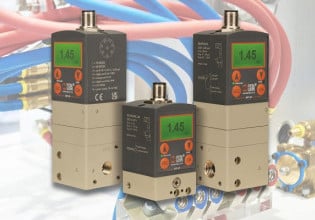CTRL F3: Factory Explosion Field Study
The CTRL F3 series reviews field studies and failures in the field focused on control fails, fixes, and facts. This article covers an explosion at an industrial sawmill.
As an Industrial Electrician and Automation Engineer, I spend the majority of my time dealing with the result of circuit failures in systems that run heavy loads.
Some days, it’s a breeze to get a call on the radio for a kicked-out motor. Head out, push a reset button, get the system running again—everyone is happy. Other times, it’s a long process of troubleshooting and finding the broken component that caused the failure.
Control F3: Failure, Fix, and Facts
Control Failure: Explosion Outside of the Factory
Imagine my surprise to hear a massive explosion outside the shop and half the facility suddenly go dark!
Not how I thought this day was going to go…

Figure 1. An explosion from a high-voltage capacitor bank. Image used courtesy of Peter Terren
At this point, it is very easy to get excited and go running outside to see what happened. Don’t let the adrenaline get to you or simply follow a huge group running toward an event like this. The most important thing for the electrician to do is to follow the standard operating procedures (SOPs) of safety.
In my facility, we wear hardhats, safety glasses, and ear protection at all times. Just because the power is out and nothing is running does not permit me to abandon the personal protective equipment (PPE) that keeps me safe.
Control Fix: Information Collection and Troubleshooting
With my basic PPE, I went out to investigate the problem and talk to anyone who might have witnessed the failure. Get this information from operators as early as possible to help direct your investigation! Here is the information I received:
- Operator 1 heard an explosion from the east right before the power went out.
- Operator 2 heard an explosion from the west right before the power went out.
- Operator 3 saw an explosion on the 7.2 kV power lines to the west.
I looked up and down the street and saw that all the power was still on for the rest of the block. Only our 10,000A main breaker was tripped. Knowing what this likely meant, I immediately returned to my shop for “the Suit.”
The Suit is what we call an arc flash suit. It is composed of insulated gloves, over which you wear traditional work gloves, overalls rated at 20 calories per square centimeter (cal/cm2) of power dissipation, along with a jacket and a hardhat/hood/visor combo all of the same rating. The suit is cumbersome, hot, and heavy, but it will keep you safe.

Figure 2. An arc flash suit. Image used courtesy of Honeywell
Having put on the suit, I walked into the main breaker house, which held the cabinet-sized breakers for each facility load center. In an attempt to isolate what piece of equipment blew the breaker, I shut off all the downstream breakers and began by turning the mains on with no load.
If there was a failure big enough to blow a 10,000A breaker at 480 VAC (volts alternating current), I did not want to push it more than I needed to. For perspective, that’s over 8.25 million watts of power with three-phase energy!
With no small amount of sweat and stress, I began to throw breakers. Each one came on with a loud BANG that scared the blazes out of me inside that suit as I waited for the one that could create a large arc flash.
It never happened.
I flipped on every breaker. The facility was powered up again. The operators tested their machines, and everything ran as it should. Nothing was tripped. Now how could that be?
I walked over to the power company personnel that had arrived to inspect their lines. They informed me that a capacitor bank had exploded on the 7.2 kV line and would require rebuilding. At this point, I started piecing together what happened.

Figure 3. A pole-mounted capacitor bank. Image used courtesy of Eaton
Control Facts: Power Factor
The initial event was the tripping of the main breaker. We found a problem with one of the biggest motors in the mill that was causing the main breaker to trip, though it took several months to hunt down the random failure.
The explosion happened next and was caused by the power factor correction capacitor bank failing. Capacitor banks on power lines are designed to perform power factor correction and reduce inductive load on the grid caused by motors and their windings. In this facility, we induce a huge amount of power factor disruption that requires constant correction at varying levels.
Power factor degradation results from large amounts of inductance being placed on the power grid without enough added capacitance to balance the system. Below is an example of a resistive and inductive load being balanced by two different capacitor examples. In the industrial facility where I work, we utilize the delta capacitors on the left example.

Figure 4. Delta and star-connected capacitor banks. Image used courtesy of Circuit Global
For a technical explanation about the calculations behind power factor correction, consider reading this following section on All About Circuits - Power Factor!
When a load system is balanced perfectly with its inductive load canceled out by the capacitive load, everything runs as normal. In a perfect world, there would be no visible anomalies. But what happens when a fully engaged capacitor bank suddenly loses the inductive load it was balancing?
To sort this out, let's try to put capacitors and inductors in simple descriptive terms. Inductors oppose changes in current at the expense of voltage. Capacitors oppose changes in voltage at the expense of current.
If we have a circuit with a huge inductive load, we require a huge capacitive load to balance it out. The capacitors and inductors work together within the system, regulating each other's changes. If we suddenly flip a breaker and remove the entire inductive side of the balance, the circuit will naturally swing the other way just like a seesaw. The capacitors attempt to hold the voltage steady at the expense of the current. It is likely to assume the current skyrocketed in order to steady the voltage and this caused the capacitor bank to explode!







Even normal HV circuit breaker makes loud bank when closing. The capacitor bank explosion would have quite loud and concerning for anybody unfortunate to be near by and witness it.